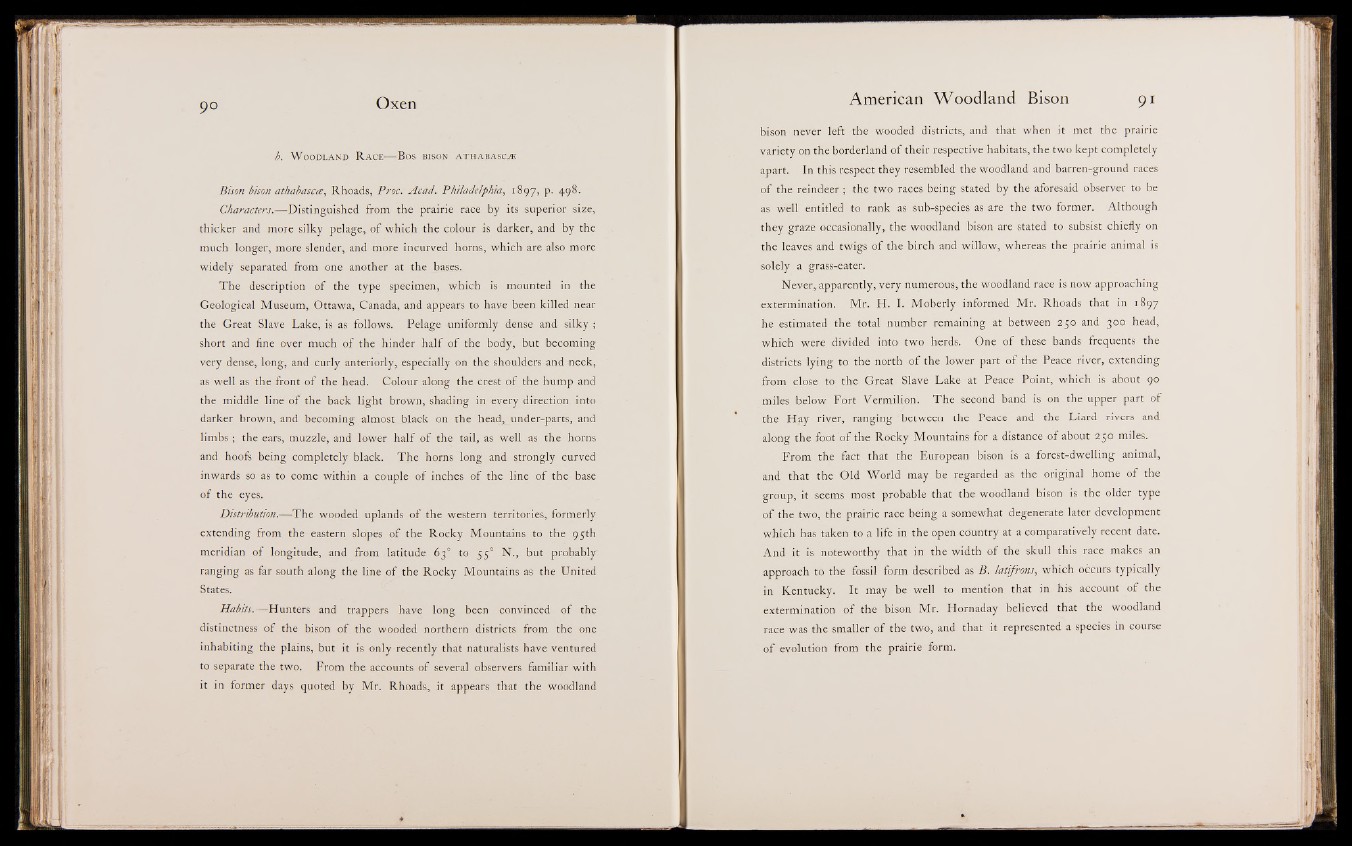
b. W oodland R a c e— B os bison a th a b a sc j®
Bison bison athabascce, Rhoads, Proc. Acad. Philadelphia, 1897, P- 49®'
Characters ^Distinguished from the prairie race by its superior size,
thicker and more silky pelage, of which the colour is darker, and by the
much longer, more slender, and more incurved horns, which are also more
widely separated from one another at the bases.
The description of the type. specimen, which is mounted in the
Geological Museum, Ottawa, Canada, and appears to have been killed near
the Great Slave Lake, is as follows. Pelage uniformly dense and silky ;
short and fine over much of the hinder half of the body, but becoming
very dense, long, and curly anteriorly, especially on the shoulders and neck,
as well as the front of the head. Colour along the crest of the hump and
the middle line of the back light brown, Shading in every direction into
darker brown, and becoming alrnostiilack on the head, under-parts; and
limbs ; the ears, muzzle, and lower half of the tail, as well as the horns
and hoofs being completely black. The horns long and strongly curved:
inwards so as to come within a couple of inches of the line of the base
of the eyes.
Distribution.^The wooded uplands o f the western territories, former™
extending from the- eastern slopes of the Rocky Mountains to the 95th
meridian of longitude, and from latitude 6 ^ t o 55HN., but probably"
ranging as far south along the linesiSf the Rocky Mountains as the United
States.
-HatorB-Hunters and trappers have long been convinced r e f the
distinctness of the bison of the wooded northern districts from the one
inhabiting the plains, but it ilj§jpnly recently that naturalists have ventured
to separate the two. From the accounts of several observers familiar with
it in former days quoted by Mr. Rhoads, it appears that the woodland
bison never left the wooded districts, and that when it met the prairie
variety on the borderland of their respective habitats, the two kept completely
apart. In this respect they resembled the woodland and barren-ground races
of the reindeer ; the two races being stated by the aforesaid observer to be
well entitledlfwrank as sub-species i f are the. two former. Although
they graze occasionally, the woodland bison are stated to subsist chiefly on
the leaves and twigs of the birch and willow, whereas the prairie animal is
B>lely a grass-eater.
Never, apparently, very numerous, the woodland race is now approaching
extermination. Mr. H. I. Moberly informed Mr. Rhoads that in 1897
he estimated the total number remaining at between 250 and head!
which were divided into two herds. One of these bands frequents the
districts lying to the north i f the lower part of the Peace river, extending
from clBeito the Great Slave Lake at Peace Point, which is about 90
miles below Fort Vermilion. The second band is on the upper part of
the Hay river, ranging "between the Peace and the Liard rivers and
along the foot of the Rocky Mountains for a distance of about .2 IB mills;
From the fact that the European b i s c g j : a forest-dwelling animal,
and that the Old World may be regarded as: theigriginal home of the
group, it Rems most probable that the woodland bison is the older type
of the twig the prairie rac!e being a somewhat degenerate later development
which has taken to a life in the open cbuntry at a comparatively recent date.
And it is noteworthy that in the width of the skull this race makes an
approach to the fossil form described as B . latifrons, which occurs typically
in Kentucky. It may be well to mention that in his account of the
extermination of the bisql Mr. Hornaday believed that the woodland
race was thSpmaller of the two, and that it represented a species in course
H f evolution from the prairie form.